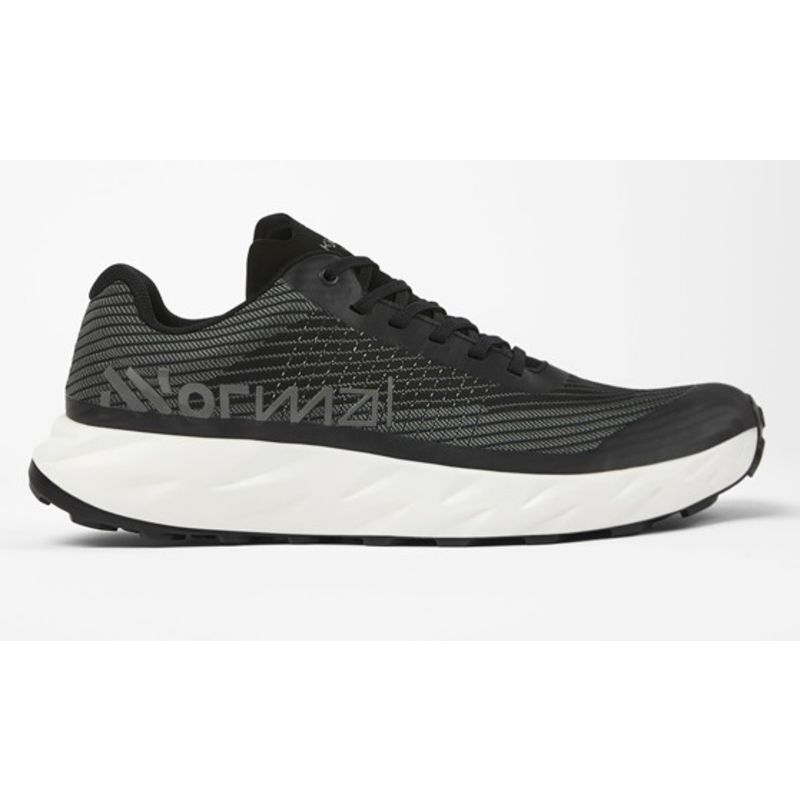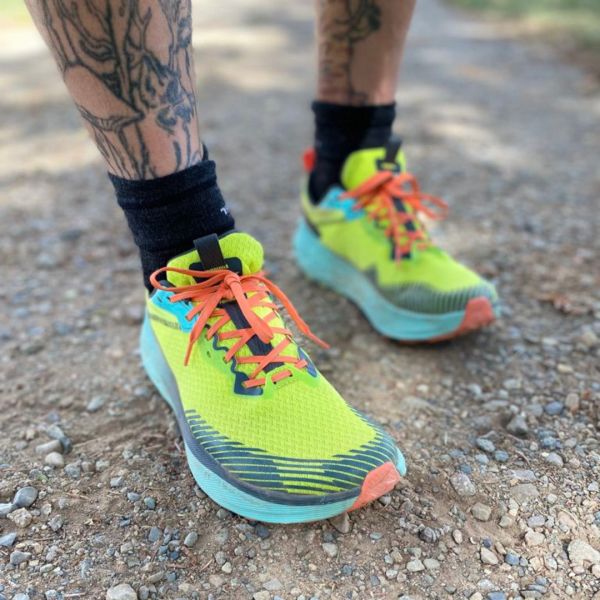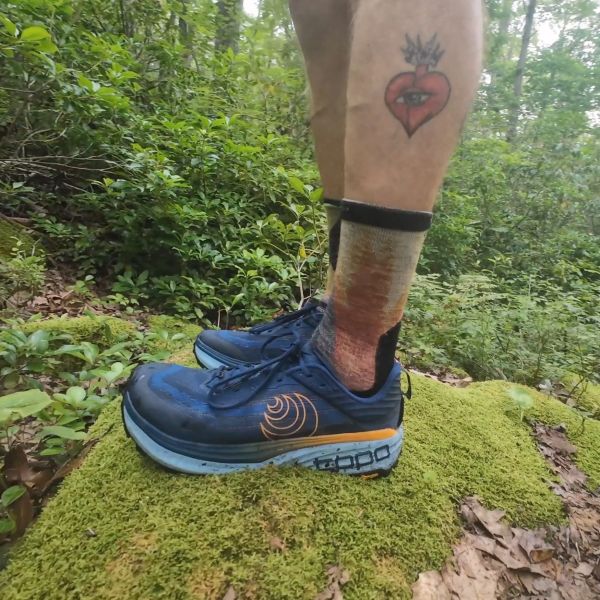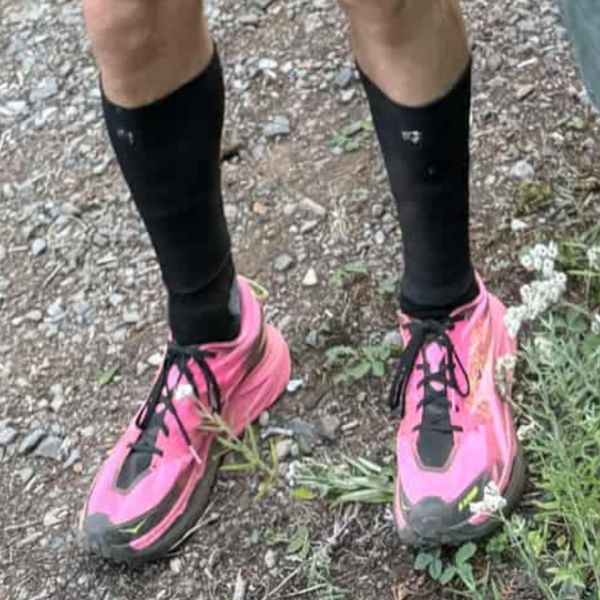
OUT OF THE BOX
Both Salomon and Nnormal are pushing the envelope for lightweight trail racing shoes and are making waves doing so. It’s a fact, lighter feels faster, but at what costs literally and figuratively? Out of the box, the Nnormal Kjerag is as comfortable as a bedtime slipper. The Pulsar with its compression sock-like upper is a bit effortful to get into, especially if you’re the type to go a half size small for that feeling of extreme snugness and control (and a few grams less weight). The Pulsar feels like getting into a rock climbing shoe and getting ready to finally send your project more than feeling like putting on a slipper for bedtime. It is worth noting that I have a narrow foot and the Nnormal fits wider than the Pulsar.
Once on and just walking around the house, the comfort of the Kjerag’s upper is undeniable and the midsole feels stiff, but stable. The Pulsar is tight in the upper, soft and bouncy in the midsole, and less stable laterally when just walking around.
Once I got to running on roads, rocks, trails, and treadmills, I found myself surprised with how the two performed and compared.
Both shoes are clearly some of the lightest cushioned trail runners on the market and neither relied on a carbon plate to make them feel fast. You can feel that lightness as you whip your feet through the gait cycle, lifting the heel, driving the knee, and lifting the toes before striking down into the ground and bounding into the next stride. You can feel this on the road and the trail, but the Pulsar really stood out above the Kjerag in this regard.
The Pulsar features a softer midsole, a narrower heel (which was another way to reduce weight and resulted in an even squishier feel thanks to less material underfoot), and a more heel to toe rocker feeling than the Kjerag.
The Kjerag midsole feels firmer underfoot, stiffer from heel to toe, and doesn’t feel like it has any propelling shape at all. When running fast on flat surfaces, I felt like I took less impact and had greater energy return and forward propulsion in the Pulsar, whereas in the Kjerag I felt significantly more of the impact forces and received no magic pep in my step.
The Pulsar having a softer midsole feels like it might lose its bounce sooner than later, and the contragrip diamond shaped lugs are smoothing out, but are still >80% of their out of the box 4.5mm depth. The Pulsar sock-like upper with the quicklace system is proving very durable for how thin and breathable it feels. Technology is coming a long way and I think Salomon nailed it with the upper material here. My pair of Pulsar’s have roughly 300 miles and are showing nearly zero wear on the upper and just a bit of foam compression and lug wear on the midsole and outsole, respectively.
The Kjerags might take the cake for durability here. With lots of snow down this winter I ran a lot of treadmill and road miles in the Kjerag and the Vibram Litebase outsole showed very little smoothing on the edges of the broad, yet sharp 3.5mm deep lugs. The midsole is quite firm and though I only have put in around 100 miles in the Kjerags, the foam is showing no compression marks, nor does it feel any softer underfoot than it did out of the box. The upper features more, thicker (and more comfortable) material than the Pulsar, and feels like it might last slightly longer thanks to some reinforcements around the foot where the upper meets the midsole.
The Pulsar is light and agile and zips along the runnable - moderately technical trails with speed and ease. On the flats and moderate inclines you can enjoy some energy return out of the midsole. On descents, you might enjoy the ease of turnover these feathers for shoes promote, but for bigger runners, you might find that the soft midsole in the narrow heel completely bottoms out and makes for some significant impact forces. This problem might be mitigated if you’re a lighter runner and/or a midfoot or forefoot striker. Being so narrow and the midsole being so soft, my feet got beat up on the very technical descents. Rocks jabbed into my foot underneath and even more so into the sides where the upper met the outsole. In a race, the excitement and focus of running dilutes the pain, but my feet are definitely more sore after the race or workout than when wearing almost any other shoe. The outsole of the Pulsar grips well on dry and soft ground (as you might expect by the shoe model’s name), but I feel that contagrip has poor grip on wet, firm surfaces like rocks, roots, and metal or wood bridges.
The Kjerag feels stable. The shoe is wider and thus provides a bigger platform underfoot and that wider base greatly decreased the number of jabs I took to the bottom sides of my feet from rocks. The firm midsole made for greater impact forces, especially on descents, but that same firm outsole is what reduced the number of jabs taken directly under the foot from rocks. The lockdown of the Kjerag is decent with its standard lacing system, but is second to the form fitting, sock like, quicklace system of the Pulsar. On the most technical terrain the Kjerag beat the ankles up more than the Pulsars. I attribute this to the firm midsole of the Kjerag not “soaking up” the terrain, but rather, the shoe abruptly takes on the angle of the surface being stepped on, and the ankle has to fight it. It’s almost like a carbon shoe in this regard, which is not a compliment. The Vibram Litebase grips decently on firm, wet surfaces as well as dry surfaces, but traction went out the window on soft ground and mud. All in all, I was very surprised to feel more in control and stable running down technical terrain in the Pulsars than the Kjerags despite thinking the outcome would’ve been the complete opposite when just standing in them fresh out of the box.
Both the Salomon Pulsar S/lab SG and the Normal Kjerag are considered high performing trail shoes. Coming from Salomon, the Pulsar has a lot of history or success behind its design, whereas although Killian is the GOAT of mountain sport and played a role in many designs from Salomon, Nnormal company is fresh off the ground and though they’re environmental friendliness might be something for bigger companies to model, they might need some time to nail the product performance they’re aiming at.
Runners with lighter frames, narrower feet, or a focus on races lasting less than a few hours might really enjoy the Pulsar experience. Runners with bigger frames, wider feet, or those looking for a shoe that has good underfoot protection yet is still featherlight might enjoy the Kjerags.
Salomon Pulsar S/lab SG
Stack : 23mm / 17mm
Drop : 6mm
Lug Depth : 4.5mm
Weight : 7.2 oz (size US M 9.5)
Nnormal Kjerag
Stack : 23.5mm/17.5mm
Drop : 6mm
Lug Depth : 3.5mm
Weight : 8.2 oz (size US M 9.5)
I received the Nnormal Kjerags in exchange for an honest review
Michael Young So you mentioned you like to size down, which I typically hear of people sizing up for more room when doing distance since feet swell and spread with time. Do you have bruised/missing toenails from doing this? European shoes get me this way since they tend to run small. Just wondering for comparison. Good compare/review!
Ja Shua Hey Michael, I was acknowledging that some people size down, but I actually prefer a little toe room so I can indeed hold onto my toenails! Haha. As a pretty true US 9.5, I thought the normal was a roomy. The Salomon was proper European snug width wise, but had the length to let my toenails breathe.
Login to your account to leave a comment.






We Want to Give it to You!
